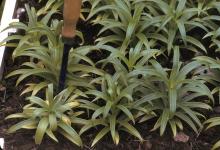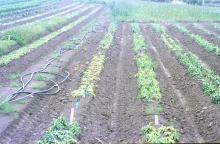See:
Lily (Lilium spp.) - Root Rots
Cause Pratylenchus penetrans and P. crenatus. P. penetrans is much more important because of its general distribution and wide host range. Distribution usually is by infected planting stock. Root-lesion nematodes are migratory endoparasites; part of the population is in soil and part in the roots at all times. Generally more damage at lower population levels in sandy soils. The complete life cycle can take from 30 to 86 days depending on temperature. Adults as well as J2, J3, and J4 can all invade roots, usually in the region of root elongation. They feed upon the cells in the root cortex. Sections of cells are killed as well as small roots. Roots generally rot due to secondary colonization by many other organisms such as fungi. Management of these nematodes is difficult with crop rotation as they have a wide host range and are supported by pasture grasses commonly used after harvest.
Symptoms Foliage that prematurely yellows from the bottom and plants that mature early in circular areas of a field usually indicate nematode damage. Infected areas may be difficult to find in an unusually wet season. Roots are greatly reduced, and most show dark lesions or dead spots. Infected plants may retain only a few stubby root remnants, the remainder having sloughed off. If plants are severely infected, bulbs have no roots left. Because infected plants are damaged and mature early, bulb size is greatly reduced.
Sampling Samples should always include soil and roots if plants are present. Take samples any time if the numbers are interpreted in relation to nematode population dynamics. In most crops, populations are relatively low through winter and spring but increase rapidly through summer. It is best to take samples in late summer to test for nematodes in fields that will be planted to lilies.
Cultural control Not effective alone.
- Pruning bulbs' roots eliminates 75% to 80% of the nematodes.
- Recently harvested, infected bulblets are treated in a hot water bath of 111°F (43.5°C) for 1 hr. Treatment is best on bulblets only, reducing the volume of treated material, and avoiding plant injury, which often follows treatment of larger bulbs. After treatment, store bulbs at 28°F for 2 months before planting again.
- Sowing marigolds directly after harvest may help reduce nematode populations in the soil.
Chemical control A combination of preplant soil fumigation followed with a nematicide at planting is necessary to manage these nematodes in southwest Oregon.
- Preplant soil fumigation controls root-lesion nematodes in soil but not those brought in later on infected nursery stock.
- Basamid at 222 to 350 lb/A for an 8-inch incorporation. 5-day reentry. Restricted-use pesticide.
- Telone II. Rates are based on planting depth and soil type. See label for details. 5-day reentry. Restricted-use pesticide.
- Telone C-17. Rates are based on planting depth and soil type. See label for details. 5-day reentry. Restricted-use pesticide.
- Vapam HL at 37.5 to 75 gal/A. Immediately after application roll the soil and follow up with tarps or a light watering. May apply through an irrigation system. 5-day reentry. Restricted-use pesticide.
- Application at planting:
- MeloCon WG (Paecilomyces lilacinus strain 251) at 2 to 4 lb/A plus a soil wetting agent applied at planting. Stable for only days at room temperature, weeks in the refrigerator or for a year if frozen. 4-hr reentry. O
- Mocap EC at 2 to 4 quarts/A. Apply over the set bulbs and cover with soil, then do final hilling as soon as practical. SLN OR-120005. 3-day reentry. Restricted-use pesticide.
- Thimet 20-G at 40 lb/A. Apply over the set bulbs and cover with soil, then do final hilling as soon as practical. Do not use if heavy rain is forecast within 48 hr of application. Runoff and/or soil water contamination is a high concern, see label for details. SLN OR-090015. 2-day reentry. Restricted-use pesticide.
Reference Chastagner, G.A., van Tuyl, J.M., Verbeek, M., Miller, W.B., and Westerdahl, B.B. 2018. Diseases of Lily. In McGovern, R.J. and Elmer, W.H. (eds.) Handbook of Florists' Crops Diseases. Springer Int.



